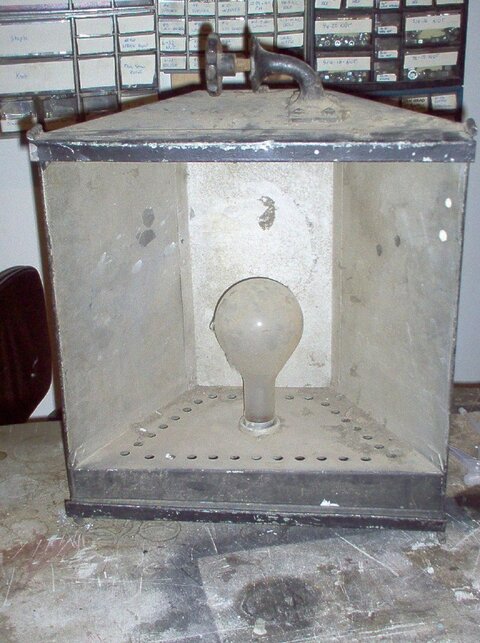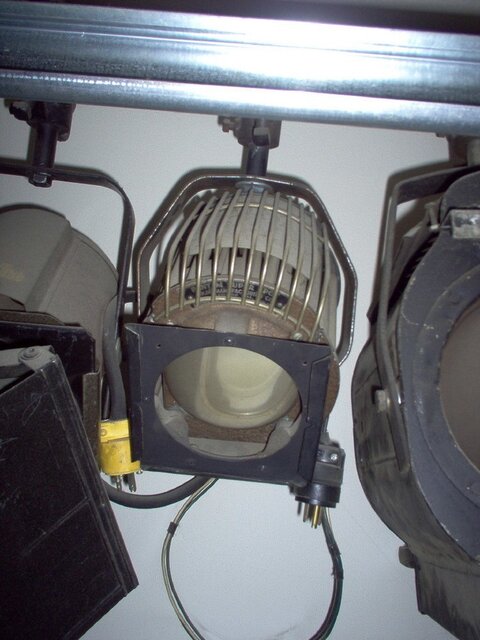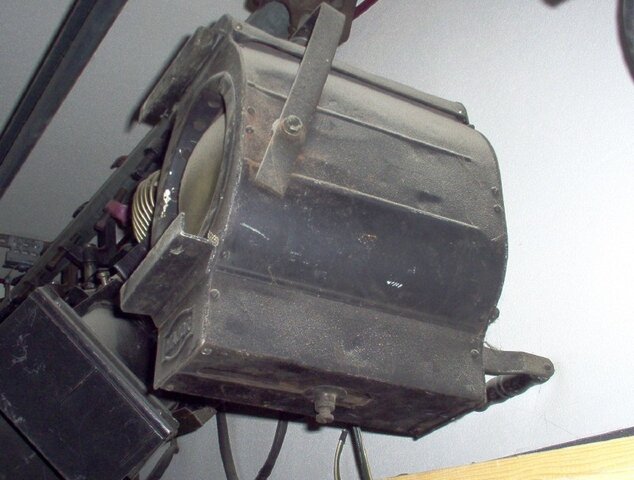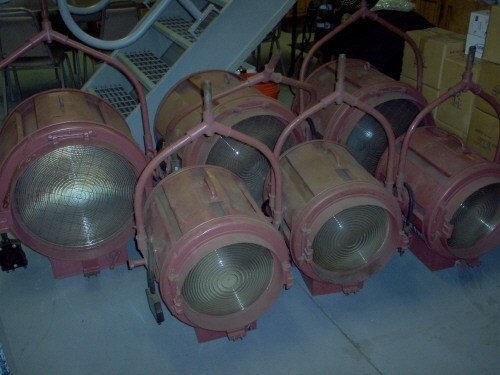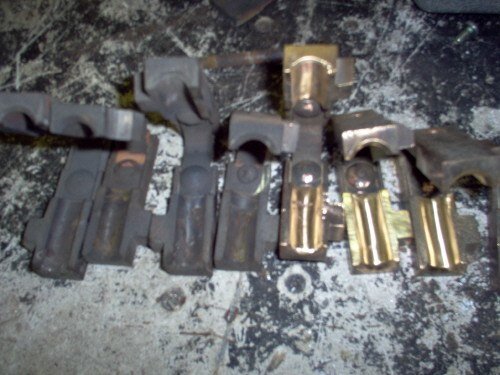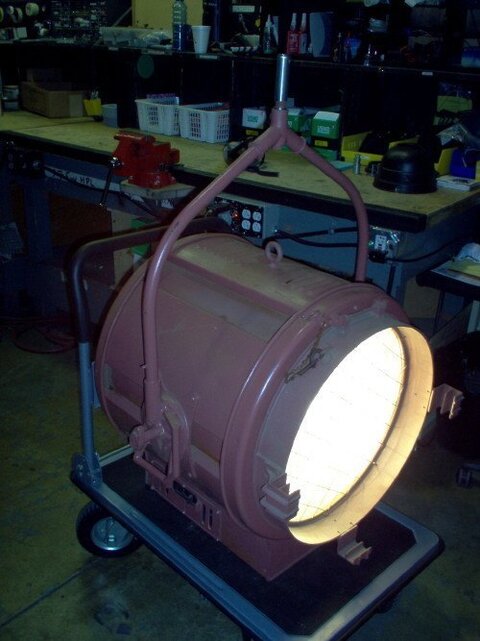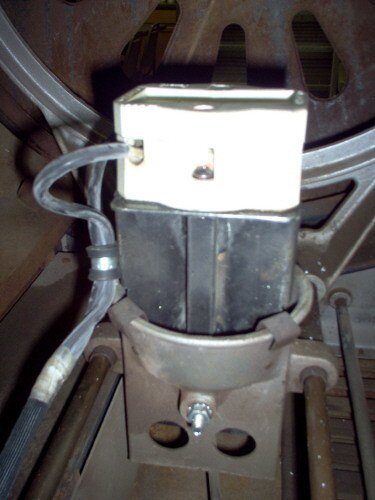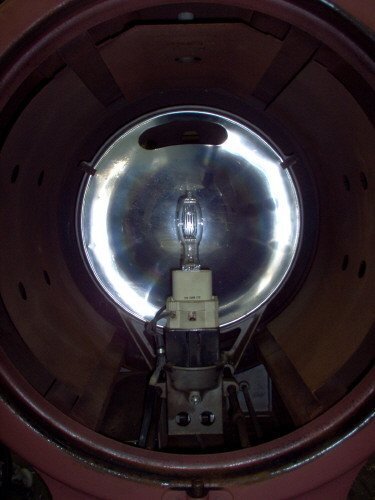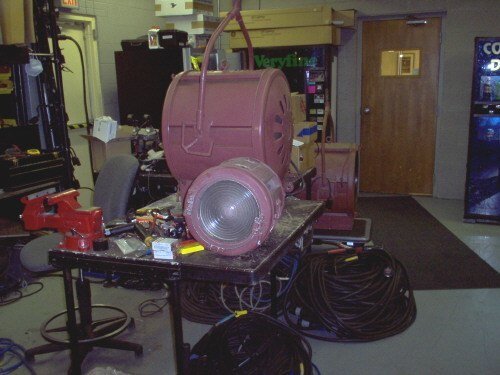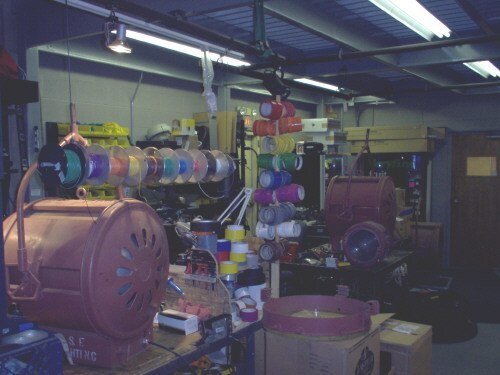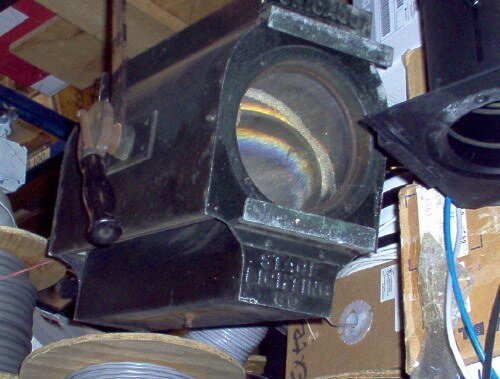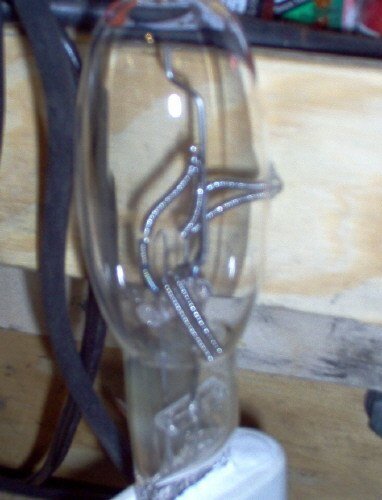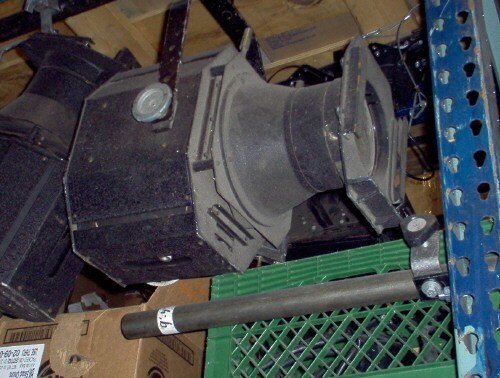I just picked up for a service call a classic +/-1920's Olivette with the triangluar inside surfaces (not painted) with 18" square gel frame. (No name brand on it, but has origional mounting hardware & knob.) From what I read in Fuchs' this is going to be the pre-1929 form of this fixture - ln newer styles as of 1929 at least in being newer, more modern ones have parabolic reflectors instead of just the angled reflector.
Was thinking that I would fix it up for the community theater that has a use for wash lights now that for the most part all but like 20 of their oldest fixtures have been re-wired and made servicable - this given well over like 150 in the inventory, and not enough dimmers to nearly power everything up. Something like 30 or 50 Fresnels alone for a like 30'x20' black box stage that so far doesn't even have any FOH lighting positions. Lekos date from the 1960's to today in all forms. Top hit is my 3.5Q5's of course with the HPR 575/115v lamps - they out punch and are more useful than the Shakespeare's in the inventory, or supplement them over the 360Q's and 360 type fixtures, though the 4.5x6.5 radial Century fixtures I would put to use at least... Fascinating... believe they have been getting the local vaudville house's scrap fixtures for the last 50 years or so. Place has more fixtures than they know what to do with - which often means just leaving them rust away in storage.
Another thing on my punch list is to do a 1.2Kw upgrade to the Altman 1000 follow spot that just sits in a corner. They use their ancient carbon arc spotlight (without ventilation) instead. Just kind of took away some of the ceiling tiles to allow the ozone to escape into the drop ceiling... Don't want the fixture for my collection but as a public service, I gotta get them at least a bit more modern. It's only like a 25' throw, you don't need the light of a carbon arc. Upgrading the Altman 1000 should prevent people with breathing problems from dying if they sit in the audience as a concept... Yep, this theater needs a lot more help than I have time to help with. There is an improvement schedule and budget for it, but it has to be tactfully done given it's a community theater that has been around for like 50 years now, and the origional tinkerers are still there.
But I'm more and more thinking that I'll trade the light for both of my 10" scoops - which are currently on loan to the theater anyway and in excellent condition, though I went silver instead of white for the reflector. That way I own it and can add it to the shop's and my antique fixture collection. It is an antique and not a great fixture to light modern shows with unless you needed a specific look in which case the fixture could be once safe, loaned to the theater - but it's time to retire it from active service. Or at least storage in a closet.
The theater I'll of course ask permission from in doing this trade but they no doubt will find more value in not spending any money on wiring this fixture and instead taking the scoops that are sized for the theater and already in use. Also in a PC way allows me to approach the subject of, yes I did loan them to the theater for a production - with lamps I bought and money invested in fixing them up, that was like a year ago. As opposed to my dimmers and Lekos they did buy, these they did not.
This fixture was sitting in the back of a closet under some boxes anyway. This old fixture along with I count seven Altman 101's though they could also and at least some of them are a 1920's box spotlight given the open faced (no lens) design of a rusty one I moved today. They are stored in the damp basement. Every time I take them up stairs, someone else brings them back down... Them was my carrot on a stick in what I want to wire, but I'm thinking instead I'll trade like five of my Altman #65Q's for seven of the PC fixtures in need of a major service call. They don't need more Fresnels but could E-Bay them off in getting cash, this as opposed to the PC fixtures that would in me owning them still be available for use, only on my dime for re-wiring and repairing them.
While not "Antique's Roadshow" by way of making antique fixtures servicable, given asbestos is a bad thing, so is rust, I take the alternate to leaving in origional condition if it's un-safe. My Dyna Beam follow spot is mint and not rusting, and the only asbestos part is the wire leads next to the lamp. these... Hopefully such an offer will be considered fair enough to make the trade - it's a shame to see them just sitting atop a shelf and rusting away in a basement.
Seemingly a few gel frames and other assemblies to misc. odd old fixtures also there all rusting in the basement that I'm slowly getting time to investigate, make servicable or trade for what is servicable. Guess I'm converting my personal light fixture inventory into an antique fixture inventory instead. Tons of barn doors and top hats also - ur... doesn't anyone use such things at this theater, why are they not prepped and ready to go?
Almost as many 1920's antique fixture styles as at the Athanaeum Theater in Chicago also rusting away in a basement. They have a few arc light spotlights and incandescent spotlights plus some of my above Olivettes in the same pre-parabolic reflector type, and a Kliegl Dynabeam (w/o boomerang) under the audience. Somewhere else in the building is a origional and theorized to still work Eisenhower light board. If anyone gets a chance to see a show or work in that space, talk to Clyde - he is a legend in Chicago theater and can show you the antiques he is proud of. At least the light board, the light fixtures are rusting away. He also is last known to own cases upon cases worth of early 1960's radial Lekos that he might be willing to sell to anyone looking for antiques. My next step is to make Clyde an offer for his antique lights and see if once the shop really does a museum, if they will buy his light board. He might be willing given he knows I will give them a good home and was trained by him. Gotta get them lights out of the basement where lime from the morter just seeps off the brick walls in a fine powder.
Just cut off the asbestos whip on this Olivette which was somehow spliced to a dry rotted 16/3 type SO cord and open faced Edison plug. Last time it was used, such a concept was that this fixture was servicable. Didn't look under the electrical tape to see if crimp splice or older solder splice, didn't want to know.
Believe I even have an extra four spoke boom base for it, though the boom with cable hook and top of boom mounted clutch is no doubt long gone, the fixture otherwise looks fairly origional. Perhaps a good clean up of the building will lead to such items.
Thus what I believe is the oldest fixture I have ever worked on to date - sitting in my garage, waiting for me to start by cleaning off years upon years worth of dust and cob webs from it. How can lighting tech people not take care of their gear like that?
Was thinking that I would fix it up for the community theater that has a use for wash lights now that for the most part all but like 20 of their oldest fixtures have been re-wired and made servicable - this given well over like 150 in the inventory, and not enough dimmers to nearly power everything up. Something like 30 or 50 Fresnels alone for a like 30'x20' black box stage that so far doesn't even have any FOH lighting positions. Lekos date from the 1960's to today in all forms. Top hit is my 3.5Q5's of course with the HPR 575/115v lamps - they out punch and are more useful than the Shakespeare's in the inventory, or supplement them over the 360Q's and 360 type fixtures, though the 4.5x6.5 radial Century fixtures I would put to use at least... Fascinating... believe they have been getting the local vaudville house's scrap fixtures for the last 50 years or so. Place has more fixtures than they know what to do with - which often means just leaving them rust away in storage.
Another thing on my punch list is to do a 1.2Kw upgrade to the Altman 1000 follow spot that just sits in a corner. They use their ancient carbon arc spotlight (without ventilation) instead. Just kind of took away some of the ceiling tiles to allow the ozone to escape into the drop ceiling... Don't want the fixture for my collection but as a public service, I gotta get them at least a bit more modern. It's only like a 25' throw, you don't need the light of a carbon arc. Upgrading the Altman 1000 should prevent people with breathing problems from dying if they sit in the audience as a concept... Yep, this theater needs a lot more help than I have time to help with. There is an improvement schedule and budget for it, but it has to be tactfully done given it's a community theater that has been around for like 50 years now, and the origional tinkerers are still there.
But I'm more and more thinking that I'll trade the light for both of my 10" scoops - which are currently on loan to the theater anyway and in excellent condition, though I went silver instead of white for the reflector. That way I own it and can add it to the shop's and my antique fixture collection. It is an antique and not a great fixture to light modern shows with unless you needed a specific look in which case the fixture could be once safe, loaned to the theater - but it's time to retire it from active service. Or at least storage in a closet.
The theater I'll of course ask permission from in doing this trade but they no doubt will find more value in not spending any money on wiring this fixture and instead taking the scoops that are sized for the theater and already in use. Also in a PC way allows me to approach the subject of, yes I did loan them to the theater for a production - with lamps I bought and money invested in fixing them up, that was like a year ago. As opposed to my dimmers and Lekos they did buy, these they did not.
This fixture was sitting in the back of a closet under some boxes anyway. This old fixture along with I count seven Altman 101's though they could also and at least some of them are a 1920's box spotlight given the open faced (no lens) design of a rusty one I moved today. They are stored in the damp basement. Every time I take them up stairs, someone else brings them back down... Them was my carrot on a stick in what I want to wire, but I'm thinking instead I'll trade like five of my Altman #65Q's for seven of the PC fixtures in need of a major service call. They don't need more Fresnels but could E-Bay them off in getting cash, this as opposed to the PC fixtures that would in me owning them still be available for use, only on my dime for re-wiring and repairing them.
While not "Antique's Roadshow" by way of making antique fixtures servicable, given asbestos is a bad thing, so is rust, I take the alternate to leaving in origional condition if it's un-safe. My Dyna Beam follow spot is mint and not rusting, and the only asbestos part is the wire leads next to the lamp. these... Hopefully such an offer will be considered fair enough to make the trade - it's a shame to see them just sitting atop a shelf and rusting away in a basement.
Seemingly a few gel frames and other assemblies to misc. odd old fixtures also there all rusting in the basement that I'm slowly getting time to investigate, make servicable or trade for what is servicable. Guess I'm converting my personal light fixture inventory into an antique fixture inventory instead. Tons of barn doors and top hats also - ur... doesn't anyone use such things at this theater, why are they not prepped and ready to go?
Almost as many 1920's antique fixture styles as at the Athanaeum Theater in Chicago also rusting away in a basement. They have a few arc light spotlights and incandescent spotlights plus some of my above Olivettes in the same pre-parabolic reflector type, and a Kliegl Dynabeam (w/o boomerang) under the audience. Somewhere else in the building is a origional and theorized to still work Eisenhower light board. If anyone gets a chance to see a show or work in that space, talk to Clyde - he is a legend in Chicago theater and can show you the antiques he is proud of. At least the light board, the light fixtures are rusting away. He also is last known to own cases upon cases worth of early 1960's radial Lekos that he might be willing to sell to anyone looking for antiques. My next step is to make Clyde an offer for his antique lights and see if once the shop really does a museum, if they will buy his light board. He might be willing given he knows I will give them a good home and was trained by him. Gotta get them lights out of the basement where lime from the morter just seeps off the brick walls in a fine powder.
Just cut off the asbestos whip on this Olivette which was somehow spliced to a dry rotted 16/3 type SO cord and open faced Edison plug. Last time it was used, such a concept was that this fixture was servicable. Didn't look under the electrical tape to see if crimp splice or older solder splice, didn't want to know.
Believe I even have an extra four spoke boom base for it, though the boom with cable hook and top of boom mounted clutch is no doubt long gone, the fixture otherwise looks fairly origional. Perhaps a good clean up of the building will lead to such items.
Thus what I believe is the oldest fixture I have ever worked on to date - sitting in my garage, waiting for me to start by cleaning off years upon years worth of dust and cob webs from it. How can lighting tech people not take care of their gear like that?
Last edited:



